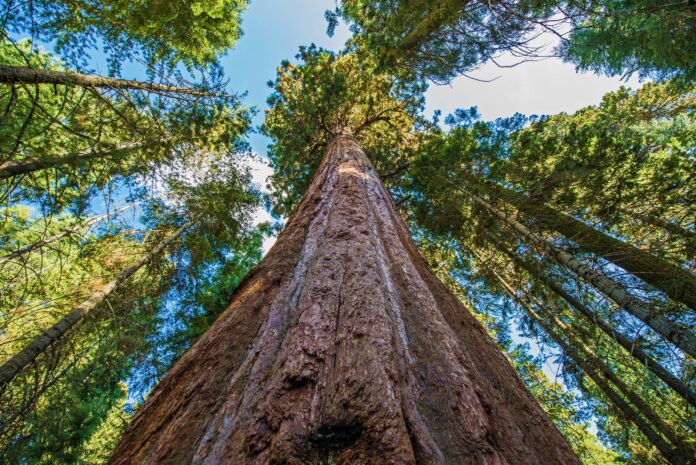On the African continent, the massive, three-girth baobab is especially revered. In Australia, people take pride in the majestic tallest eucalyptus. However, the unrivaled champions of tree height are of one species—the sequoias. This redwood with evergreen foliage from the cypress family grows on the western coast of America, along the Pacific in California.
An Unexpected Discovery
Over many years of observation, several trees of this species have held the title of the tallest. From 1996 to 2000, for example, the Mendocino Sequoia held first place with a height of just over 112 meters. Later, trees that were 20–30 centimeters, or even 1–2 meters taller, were discovered.
In 2006, a chance discovery was made: the Hyperion Sequoia, which stood 3.5 meters closer to the sun. The tree was last measured in 2015. It was found by young biologists Atkins and Taylor while conducting research in California’s Redwood National Park. A group of scientists was immediately dispatched to the park to make precise measurements. Ecologist Stillet climbed to the very top of the tree and lowered a tape measure. He also noted that woodpeckers had settled in the upper branches, likely slowing its growth.
This tree is so massive that it’s impossible to photograph the entire tree from the ground. Only from a bird’s-eye view or a helicopter can one capture its full height. To imagine its height, you could compare the giant tree to the British Big Ben or the American Statue of Liberty—it’s about 20–30 meters taller than either.
Kept Away from Tourists
The name “Hyperion” comes from ancient Greek mythology: it was the name of one of the twelve titans, the children of Heaven and Earth.
The California authorities keep the tree’s exact location a strict secret, fearing an influx of tourists. The pilgrimage of travelers could disrupt the fragile ecosystem and worsen the tree’s growth conditions. There’s also the danger that visitors might carve their names into the bark or take a piece of it as a souvenir.
The tallest tree in the world is still “young”—it’s only 700–800 years old. According to scientists, that’s roughly equivalent to 20 human years, meaning the titan has plenty of time to remain the height record holder for years to come.
A Miraculous Rescue
Redwoods have always been highly valued. Upon hearing that a national park was to be established in California’s Redwood Valley, lumber companies began mercilessly cutting down the ancient forests. Workers toiled around the clock, leaving behind barren lands where sequoia groves once stood.
This took place in the latter half of the 20th century. The park was finally opened just as loggers were approaching Hyperion. With the park’s creation came a strict ban on tree cutting. Had it not been for human intervention, some of these destroyed sequoias might have become record-breakers. Today, only 5% of the redwood forests in America have been saved.
Profile of Hyperion
The crown of this unique tree is conical, with horizontal branches. Its bark is several dozen centimeters thick, yet surprisingly silky to the touch.
“Young” sequoias—under 100 years old—form a green pyramid without the slightest gap. Over time, branches begin to fall, leaving the lower trunk bare. This is also the case with Hyperion, which has a powerful, bare trunk and a majestic crown. Its leaves are scaly, and its cones can be up to 20 centimeters long.
Interesting Facts
Nature endowed the sequoia with an exceptional ability to purify the air from carbon dioxide—far better than any other known plant on Earth. If a landowner decides not to cut down these trees, they receive what is called a carbon credit from the government.
Fire has an unusual effect on sequoias. The bark does not burn, and flames, in fact, create favorable soil conditions for young shoots. Additionally, the heat from a fire helps cones open faster, allowing seeds to fall into the prepared ground.
A redwood will thrive anywhere, but it will grow more slowly and is unlikely to reach the height of its Californian counterparts.
According to scientists, the maximum height a tree can reach is 130 meters. This is the limit of the plant’s capabilities: less moisture and nutrients will reach the crown, and further growth will no longer be possible.
Hyperion still has several years left to hold the title of the tallest tree in the world. It is being closely followed by Helios, another member of the cypress family, which is rapidly growing. Over six years of observation, the difference in height between the two trees has gradually decreased, and today it stands at just one meter.
